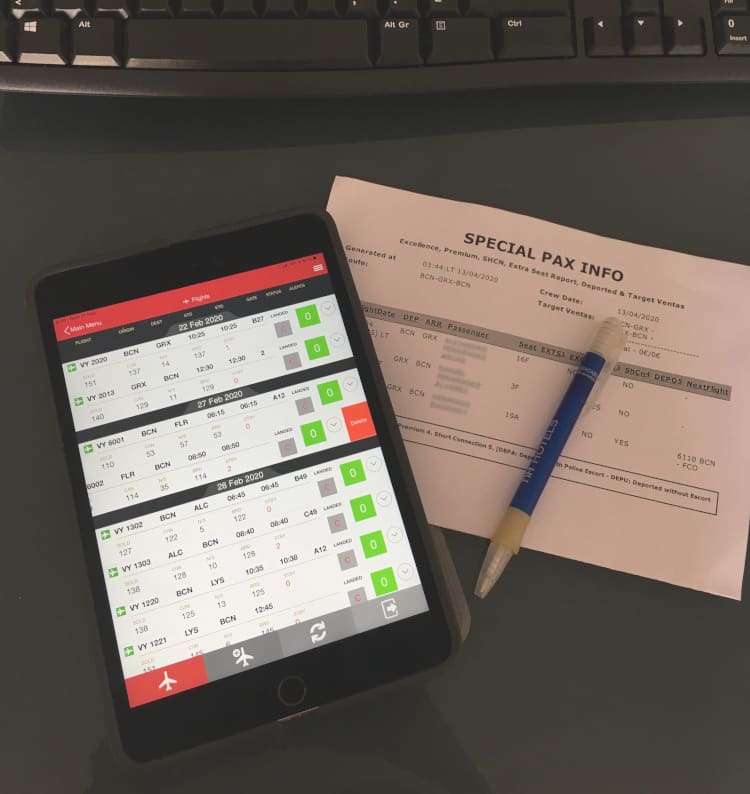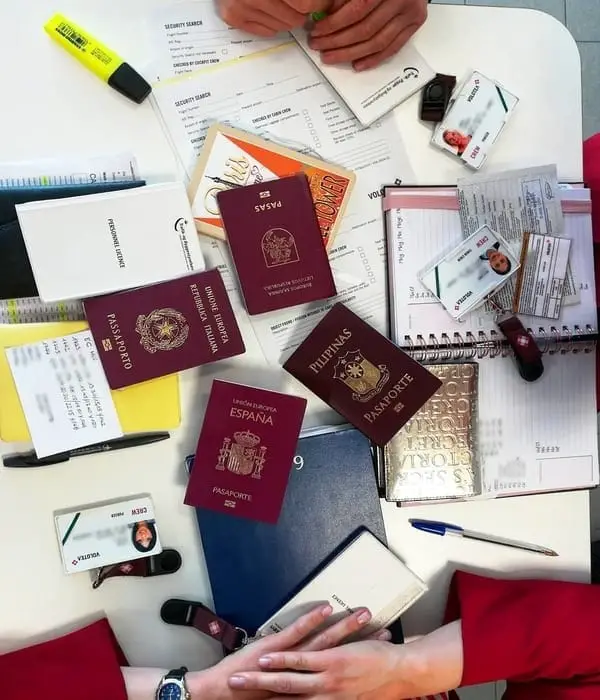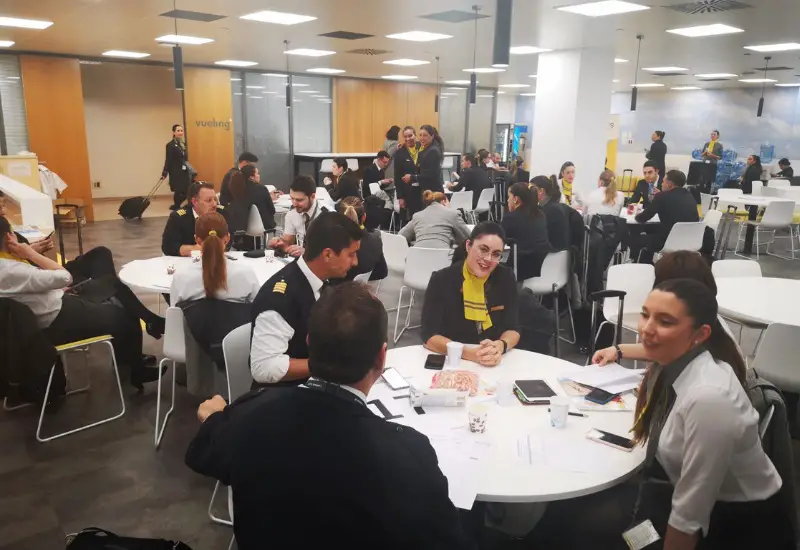Safety is the number one value when it comes to the airline industry. That’s why as a cabin crew, one of the most important aspects of the job is to complete a pre-flight briefing.
A pre-flight briefing is a very important element of flight preparation and is always carried out before every flight to allow the flight attendants to communicate important information to each other and ensure that all crew members are on the same page when it comes to the safety of the aircraft and the passengers.
Let’s learn a bit more about cabin crew briefings.
What is a cabin crew pre-flight briefing?
It’s basically a short meeting between flight attendants – and pilots – prior to the flight.
During the pre-flight briefing, introductions occur, flight details, cockpit communication, passenger information, crew checks, and any other important information that may lead to a more safe and comfortable flight.
A pre-flight briefing also may reduce any errors or potential incidents during flight since you and your crew are creating a strong team prior to boarding and setting a positive tone.
Why is a cabin crew pre-flight briefing necessary and so important?
A cabin crew pre-flight briefing ensures that flight attendants are on the same page in terms of safety and comfort of the passengers.
Flight attendants need to be able to work together well and communicate effectively in the case of an emergency. In the event of an emergency, each flight attendant must have what they need, be prepared, and be able to react and work with the rest of the crew successfully and efficiently.
A clear example of this is a fire on board. A fire can be one of the most dangerous situations that can occur at any stage and the crew has very little time to put it out before the situation gets out of control.
So there is a very specific procedure to follow and everyone needs to know what to do precisely:
- One flight attendant will be the firefighter
- A second flight attendant will assume the role of communicator, notifying other flight attendants of the situation, and maintaining communication with the flight deck.
- The flight crew will take immediate action in order to start eliminating the smoke, or fire – eg: if the fire is in the cargo compartment – and if the fire cannot be immediately extinguished, the pilots have minutes to find a place to land safely.
- A third flight attendant will be providing back-up fire-fighting equipment – a second Fire extinguisher or others- to the firefighter
- Once the fire is controlled the Purser (Cabin Manager) will confirm that the fire is completely out and explain the situation to the flight crew.
So, as you see it’s all based on teamwork and good communication.
Where and when is the briefing usually held?

Typically, the pre-flight briefing is held in the crew room or on the aircraft prior to boarding.
A crew room is a room designated at the airport for flight attendants and pilots to rest, eat, obtain paperwork, or seek assistance from management. Also, flight attendants that are on airport standby typically will rest in the crew room until they are called to operate a flight.
Depending on the airline, the briefing may be 1-2 hours before the flight actually departs.
The time of the briefing is typically also considered the report time for the flight attendant.
The purser or lead flight attendant conducts the briefing and goes through a series of topics to ensure each flight attendant is prepared.
It can last from 10 to 30 minutes, depending on how much time you have and what it’s covered.
Here’s a video to understand what we really do from the moment we get to the airport.
What are the topics covered?
Introduction
Flight attendants start the briefing off by introducing themselves to each other.
Depending on the airline and base, the flight attendants may or may not know each other already.
A base is the airport in which a flight attendant works from and will always start a trip from.
The smaller the base, the more likely the flight attendants already know each other.
This is a great time to memorize everyone’s names!
Flight details
The lead flight attendant will go through important flight details with the crew to ensure everybody is aware and on the same page.
Some details that may be covered are the aircraft type, the flight number, the flight destination, any time changes, the flight time, and the estimated time of departure and arrival.
The pilots may also go over the flight details to ensure the flight attendants are also on the same page.
Typically, passengers will ask for these details throughout the flight as well.
Cockpit communication
The pilots will join the pre-flight briefing either in the crew room or on the aircraft prior to boarding at some point.
During this time, the pilots will go over emergency and normal communication and entry procedures.
If there is an emergency and the flight attendant must enter the cockpit without the pilot’s request, then the flight attendant must know how to do so.
However, on a normal day, the pilots and flight attendants must communicate how to enter and exit the cockpit in order to give the pilots a short break.
The pilots will also go over the weather if they are expecting turbulence and the flight route.
The flight crew will also encourage the cabin crew to report anything safety related to them.
Passengers
The lead flight attendant will review the number of passengers on board and go through a list of any specials on the flight.
Specials are known as any passenger that may require a specific need.
For example, a UM is an unaccompanied minor and must be noted by the flight attendants.
Once the UM is onboard the aircraft, the UM is under the care and supervision of the flight attendants.
Wheelchair customers, deaf or blind passengers, those traveling with animals, people with dietary restrictions such as gluten-free and nut allergies, or any other passenger with a specific need will be noted during this time.

Crew
The lead flight attendant will perform an appearance check to ensure that each flight attendant is in a compliant uniform and is properly groomed.
The lead flight attendant will also delegate and ensure everyone’s position on the aircraft and work duties.
They may review the order of service to include drinks, food, and clean up.
Depending on the airline, they will also check for passports, visas, paperwork, manuals, and if they are fit to fly.

The lead flight attendant may also ask a security question to ensure everyone is aware and up to speed with proper work rules and requirements.
A security question is safety-related and simply a spot check. If the flight attendant doesn’t know the answer, most airlines policy is to explain the answer in detail and provide information in the manuals pertaining to that topic.
An example of a briefing question is:
Can you tell me what would you do if there is black smoke in the cabin?
Finally, if there is a layover, the lead flight attendant may ask for phone numbers or room numbers as well.
Below are an example of pre-flight briefing. It’s just a practice but it gives you an idea.
What happens after the pre-flight briefing?
Once the pre-flight briefing is complete, you are all ready to go.
The crew will proceed to the gate and check-in with the gate agent.
The gate agent will then allow the flight attendants and pilots to board the aircraft to prepare it for departure.
One of the first things flight attendants do once they board the aircraft is perform their pre-flight checks and security search.
Each flight attendant is assigned a position on the aircraft and that position also correlates with their area to perform the check.
They must inspect each piece of emergency equipment and ensure the aircraft is equipped with emergency supplies.
For example, the flight attendant must ensure that the jump seats are in proper working order but ensuring the harnesses work properly and are not frayed.
They must also check that the AED is in working order, the flashlights work, and that there is a life vest under each passenger seat.
Depending on the flight attendant’s position, they may have several pieces of emergency equipment to check.
If there are any incidents or unusual events that occur during the flight, they must be reported to the pilots and properly dealt with.
After the flight, there may also be a post-flight de-briefing. This may be completed on the aircraft or in the crew room depending on the situation.
This time is used to discuss the irregularity that occurred, complete paperwork, and ensure that the incident has been resolved.
How can I prepare for my first pre-flight briefing?
- In order to best prepare you should always be punctual! Being a little early is even better but ensure that you are on time for your report.
Most airlines have a policy that either remove a flight attendant from a trip if they are late, or they are given a negative point.
A flight attendant may be let go if they accumulate too many negative points.
A flight attendant also works with their crew to ensure the safety of the passengers and aircraft. As a team player, you should be on time to your report. - To prepare for the briefing, you may also review your safety drills, equipment checks, and any other important information that you may discuss during the briefing.
- Finally, triple-check that you have packed all of your required items. The lead flight attendant will check for these items so you should always ensure you are prepared prior to the pre-flight briefing.
The pre-flight briefing is an important aspect for increasing safety and security so do your part to ensure that your flight is successful!


Thank you for this info! It was truly helpful!
Thanks! You’re welcome!